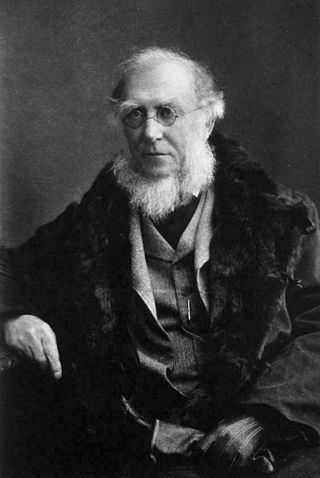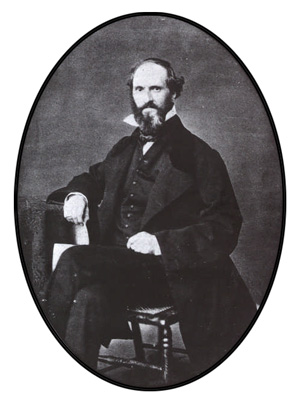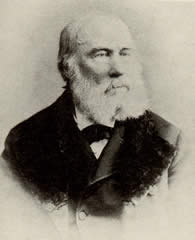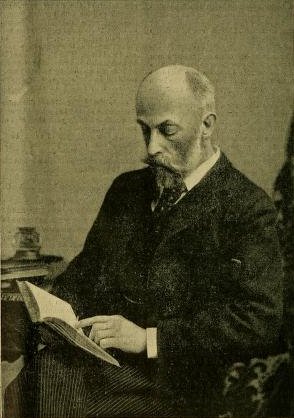
Royal Botanic Gardens, Kew is a non-departmental public body in the United Kingdom sponsored by the Department for Environment, Food and Rural Affairs. An internationally important botanical research and education institution, it employs 1,100 staff. Its board of trustees is chaired by Dame Amelia Fawcett.

Kew is a district in the London Borough of Richmond upon Thames. Its population at the 2011 census was 11,436. Kew is the location of the Royal Botanic Gardens, now a World Heritage Site, which includes Kew Palace. Kew is also the home of important historical documents such as Domesday Book, which is held at The National Archives.

Sir Joseph Dalton Hooker was a British botanist and explorer in the 19th century. He was a founder of geographical botany and Charles Darwin's closest friend. For 20 years he served as director of the Royal Botanical Gardens, Kew, succeeding his father, William Jackson Hooker, and was awarded the highest honours of British science.

Sir William Jackson Hooker was an English botanist and botanical illustrator, who became the first director of Kew when in 1841 it was recommended to be placed under state ownership as a botanic garden. At Kew he founded the Herbarium and enlarged the gardens and arboretum. The standard author abbreviation Hook. is used to indicate this person as the author when citing a botanical name.

Richard Spruce was an English botanist specializing in bryology. One of the great Victorian botanical explorers, Spruce spent 15 years exploring the Amazon from the Andes to its mouth, and was one of the first Europeans to visit many of the places where he collected specimens. Spruce discovered and named a number of new plant species, and corresponded with some of the leading botanists of the nineteenth century.

Walter Hood Fitch was a botanical illustrator, born in Glasgow, Scotland, who executed some 10,000 drawings for various publications. His work in colour lithograph, including 2700 illustrations for Curtis's Botanical Magazine, produced up to 200 plates per year.
The 1893 Index Kewensis (IK), maintained by the Royal Botanic Gardens, Kew, is a publication that aims to register all botanical names for seed plants at the rank of species and genera. It later came to include names of taxonomic families and ranks below that of species.
Reginald Hawthorn Hooker English civil servant, statistician, and meteorologist. Hooker was a pioneer in the application of correlation analysis to economics and agricultural meteorology.

Sir William Turner Thiselton-Dyer was a leading British botanist, and the third director of the Royal Botanic Gardens, Kew.

The Botanical Magazine; or Flower-Garden Displayed, is an illustrated publication which began in 1787. The longest running botanical magazine, it is widely referred to by the subsequent name Curtis's Botanical Magazine.

Phormium colensoi, also called mountain flax, or wharariki in Māori, is a perennial plant that is endemic to New Zealand. The greenish, yellow or orange flowers are followed by twisted seed pods. It is less common than the other Phormium species, P. tenax or harakeke. Mountain flax is also called whararipi, whatariki, mangaeka, kōrari tuauru, wauraki, coastal flax, hill flax and lesser New Zealand flax.

Matilda Smith (1854–1926) was a botanical artist whose work appeared in Curtis's Botanical Magazine for over forty years. She became the first artist to depict New Zealand's flora in depth, the first official artist of the Royal Botanic Gardens at Kew, and the second woman to become an associate of the Linnaean Society. The standard author abbreviation M.Sm. is used to indicate this person as the author when citing a botanical name.

Pholidostachys is a genus of palms found in Central America and northwestern South America.

Senecio bahioides is a flowering plant species of the genus Senecio and family Asteraceae. It is a native of Chile.

William Brian Hooker was an American poet, educator, lyricist, and librettist. He was born in New York City, the son of Elizabeth Work and William Augustus Hooker, who was a mining engineer for the New York firm of Hooker and Lawrence. His family was well known in Hartford, Connecticut having descended from Thomas Hooker, a prominent Puritan religious and colonial leader who founded the Colony of Connecticut.

St Anne's Church, Kew, is a parish church in Kew in the London Borough of Richmond upon Thames. The building, which dates from 1714, and is Grade II* listed, forms the central focus of Kew Green. The raised churchyard, which is on three sides of the church, has two Grade II* listed monuments – the tombs of the artists Johan Zoffany and Thomas Gainsborough. The French Impressionist painter Camille Pissarro (1830–1903), who stayed in 1892 at 10 Kew Green, portrayed St Anne's in his painting Church at Kew (1892).
Belonophora coffeoides is a species of flowering plant in the family Rubiaceae. It is found in Tropical Africa. It is the type species of the genus Belonophora.

Hooker's Journal of Botany and Kew Garden Miscellany was a scientific journal edited by Sir William Hooker that was published in nine volumes between 1849 and 1857.

The Flora Antarctica, or formally and correctly The Botany of the Antarctic Voyage of H.M. Discovery Ships Erebus and Terror in the years 1839–1843, under the Command of Captain Sir James Clark Ross, is a description of the many plants discovered on the Ross expedition, which visited islands off the coast of the Antarctic continent, with a summary of the expedition itself, written by the British botanist Joseph Dalton Hooker and published in parts between 1844 and 1859 by Reeve Brothers in London. Hooker sailed on HMS Erebus as assistant surgeon.
















